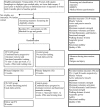FAST CP: protocol of a randomised controlled trial of the efficacy of a 12-week combined Functional Anaerobic and Strength Training programme on muscle properties and mechanical gait deficiencies in adolescents and young adults with spastic-type cerebral palsy
- PMID: 26116614
- PMCID: PMC4486965
- DOI: 10.1136/bmjopen-2015-008059
FAST CP: protocol of a randomised controlled trial of the efficacy of a 12-week combined Functional Anaerobic and Strength Training programme on muscle properties and mechanical gait deficiencies in adolescents and young adults with spastic-type cerebral palsy
Erratum in
-
Correction.BMJ Open. 2015 Jul 27;5(7):e008059corr1. doi: 10.1136/bmjopen-2015-008059corr1. BMJ Open. 2015. PMID: 26216153 Free PMC article. No abstract available.
Abstract
Introduction: Individuals with cerebral palsy (CP) have muscles that are smaller, weaker and more resistant to stretch compared to typically developing people. Progressive resistance training leads to increases in muscle size and strength. In CP, the benefits of resistance training alone may not transfer to improve other activities such as walking; however, the transfer of strength improvements to improved mobility may be enhanced by performing training that involves specific functional tasks or motor skills. This study aims to determine the efficacy of combined functional anaerobic and strength training in (1) influencing muscle strength, structure and function and (2) to determine if any changes in muscle strength and structure following training impact on walking ability and gross motor functional capacity and performance in the short (following 3 months of training) and medium terms (a further 3 months post-training).
Methods and analysis: 40 adolescents and young adults with CP will be recruited to undertake a 12-week training programme. The training programme will consist of 3 × 75 min sessions per week, made up of 5 lower limb resistance exercises and 2-3 functional anaerobic exercises per session. The calf muscles will be specifically targeted, as they are the most commonly impacted muscles in CP and are a key muscle group involved in walking. If, as we believe, muscle properties change following combined strength and functional training, there may be long-term benefits of this type of training in slowing the deterioration of muscle function in people with spastic-type CP.
Ethics and dissemination: Ethical approval has been obtained from the ethics committees at The University of Queensland (2014000066) and Children's Health Queensland (HREC/15/QRCH/30). The findings will be disseminated by publications in peer-reviewed journals, conferences and local research organisations' media.
Trial registration number: Australian and New Zealand Clinical Trials Registry (ACTRN12614001217695).
Keywords: Cerebral Palsy; Muscle; RCT; Resistance training.
Published by the BMJ Publishing Group Limited. For permission to use (where not already granted under a licence) please go to http://group.bmj.com/group/rights-licensing/permissions.
Figures


References
-
- Access Economics. The economic impact of cerebral palsy in Australia in 2007: Report for Cerebral Palsy Australia, 2008.
-
- Lance JW. Symposium synopsis. In: Feldman RG, Young RR, Koella WP eds. Spasticity: disordered motor control. Chicago: Year Book Medical Publishers, 1980:485–95.
Publication types
MeSH terms
Associated data
LinkOut - more resources
Full Text Sources
Other Literature Sources
Medical
Miscellaneous
